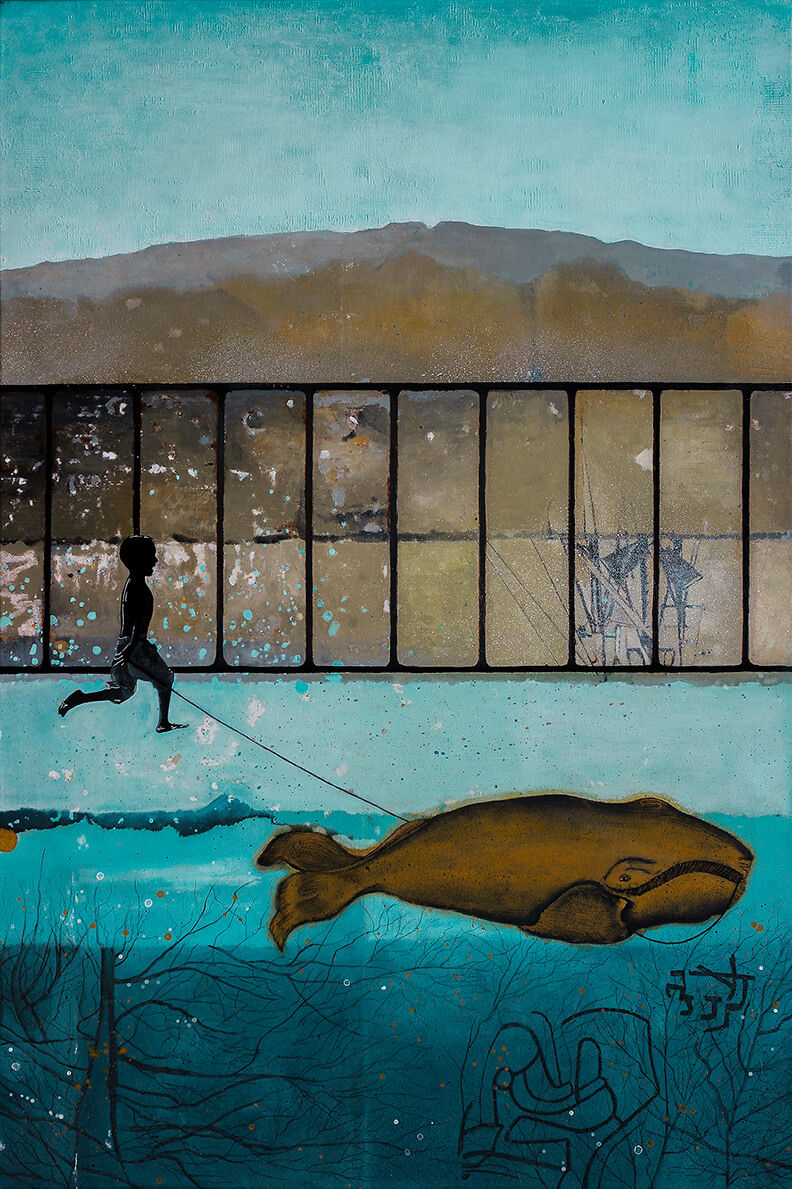Wabi-Sabi art in the West – Why imperfection feels perfect
- dbwaterman
- Jul 13
- 6 min read
Updated: Jul 19
In Japanese philosophy, Wabi-Sabi art revolves around the beauty of imperfection, transience, and incompleteness.
It is not about sleek design, symmetry, or gloss, but rather the quiet poetry of the weathered, the irregular, and the broken.
This makes art honest. Things that are not perfect are also beautiful.
For me as a mixed media artist, this is not a concept, but a way of looking at the world and, as a result, a way of working. It is the basis of many of my artworks: rough, weathered, and imperfect images built up from layers, chance, and traces of the past.
What is Wabi-Sabi?
Wabi-Sabi is an aesthetic and philosophical concept from Japan that sees beauty in the transitory and the imperfect. Objects may have cracks. Surfaces may be covered with moss. Paper may be yellowed and stained.
But also, for example, a quiet marsh landscape in fog. Instead of striving for perfection, according to the Wabi-Sabi philosophy, beauty lies in what is worn, transient, or incomplete.
In the Western art tradition, the emphasis has long been on symmetry, control, and perfect lines. But at the moment, there is a growing appreciation for the exact opposite of perfection: appreciation for weathered art, rough textures, and images in which imperfection plays the leading role. What is Wabi-Sabi?
Wabi-Sabi is an aesthetic and philosophical concept from Japan that sees beauty in the transitory and the imperfect. Objects may have cracks. Surfaces may be covered with moss. Paper may be yellowed and stained.
But also, for example, a quiet marsh landscape in fog. Instead of striving for perfection, according to the Wabi-Sabi philosophy, beauty lies in what is worn, transient, or incomplete; Wabi-Sabi Art
Wabi-Sabi art has seven principles. These make it easier to understand this art form:
Kanso: Simplicity, the beauty of the unadorned.
Fukinse: The asymmetry and irregularity found in natural forms.
Shibumi: Understated beauty or understated elegance.
Seijaku: Tranquility that comes from silence and contemplation.
Shizen: Naturalness, a sense of unadulterated authenticity.
Datsuzoku: Unconventional, free from norms.
Yugen: Sincere mystery, an evocation of the invisible depths.

Imperfections as a working method
I don't see imperfections in art as a limitation, but rather as a starting point. Almost all of my mixed media artworks are based on the imperfections of weathered layers. I work with collage, image transfer, acrylic paint, ink, pastel chalk, and paper.
These materials are deliberately mixed together to create my ‘perfectly imperfect’ surface and background. Stains, cracks, old texts, rusted surfaces, and peeling paint are given a prominent role. I often consciously copy worn surfaces: concrete, rust, weathered walls, swampy ground, or dried-out desert textures. Sometimes literally, sometimes as an atmosphere, as an underlayer, as traces.
Even my painting tools are not perfect. Once purchased as beautiful new brushes, most of them are now broken and worn out from the rough work they have to do. And that's how it should be, because it allows me to do my work better.
A smooth canvas is rare for me. The surface is usually made up of different layers—sometimes visible, sometimes hidden—giving each work its own history. That layering is never planned, but arises in the process. I work intuitively. Sometimes I leave a work lying around for weeks, then I scratch away a part, add a forgotten poster fragment, or let paint drip over an almost finished image.
Wabi-Sabi art with weathered materials
The materials I use in my ‘Wabi-Sabi’ art are usually already weathered, worn, and perishable. I use yellowed paper, torn posters, posters with text, concrete texture, rust spots, and crackled layers. These elements give the work a certain tranquility. I want to depict the passage of time. To show that it is something beautiful.
Weathered art does not usually evoke the same admiration as technically perfect painted works of art.
But imperfect art does have the power to silence the viewer. Weathered art evokes a certain atmosphere, a memory, or an emotion that is difficult to put into words. As a viewer, you can wander through weathered and layered landscapes. You can lose yourself in your own story.
A desert is not just dry, barren, and empty. A swamp is not just dark and ugly. These natural, irregular, and unpredictable landscapes embody precisely what Wabi-Sabi refers to: a beauty that does not demand attention but is quietly present. Ignored by many, but not by mixed media artist db Waterman, who uses precisely these kinds of images in her weathered ‘Wabi-Sabi’ art.
Western Wabi-Sabi: the imperfect counterpart to perfection
In Western culture, the pursuit of perfection in art is often the most important goal.
Think, for example, of the retouching of images and the use of digital filters. In that case, imperfection works as a breath of fresh air. Art does not have to be smooth and polished to be beautiful. On the contrary. It is the imperfection that adds something human. And that is precisely what touches the viewer more often.
That is why Wabi-Sabi is a counter-movement in Western art. At first glance, Wabi-Sabi art seems sloppy and unfinished. But it is precisely about allowing chance to happen. In my artworks, I receive gifts by working in this way; seeing what emerges by combining layers or omitting parts.
My work shows traces of damage: in an imprint that is not quite perfect, in an old text that remains half legible, in a stain that was not planned but takes on meaning.
These elements bring a work of art to life. Not as something that is finished, but as something that continues to develop, also for the viewer. You can always discover something new, precisely because the image is not complete and perfect. And as a viewer, you can also fill in the parts that seem to be missing.
Peace and space in imperfection
Many people who view my mixed media artworks experience peace and comfort in my work. My paintings are not always cheerful, but they offer space and the opportunity to find recognition in an image.
The landscapes are not full or loud, the figures are often alone and silent.
Wabi-Sabi imperfection gives the possibility. Imperfection opens a door. It says: it is good as it is. That too is Wabi-Sabi.
A rough wall, a rusty surface, a crack in a sculpture: these are signs of life, of living through. In a world full of speed and digital smoothness, it is precisely the art that dares to be imperfect that makes us pause.
Read also blog 5: Comfort in roughness on this theme. ( Coming soon )
Conclusion: Imperfection as an invitation
Wabi-Sabi art teaches us that beauty lies not in what is finished, but in what is in progress. Something the Japanese have known for a long time.
My art follows that philosophy. When I start a new artwork, there is no clear goal, no strict design. A new artwork is an interplay of diverse materials, feelings, chance, and traces. Whether it's layers of collage, a layer of concrete paint, or a lost word: everything contributes to the meaning.
Imperfection in art offers great freedom. It gives the viewer a chance to fill in the image where things seem to be missing. And perhaps that's the most beautiful thing: that in the broken, the weathered, the unfinished, we find something that resonates with us.
Frequently Asked Questions
Is Wabi-Sabi art only suitable for a home with a Japanese interior design style?
Art that embodies the Japanese Wabi-Sabi philosophy fits perfectly into many different interior styles. It works well in modern, minimalist, and traditional interiors. The Wabi-Sabi art by db Waterman is very diverse, so there's a suitable artwork for every interior.
Is Wabi-Sabi art also suitable for the bedroom, and what are the best colors to use?
This art form is particularly well-suited for the bedroom! A bedroom should offer peace and tranquility. The best colors for the bedroom are found in the Wabi-Sabi style. Think of warm grays, natural earth tones, pale blues, and greens. Soft colors that make the bedroom a place of serenity.
Can Wabi-Sabi art be used in office spaces?
Yes, that's a perfect fit! By using natural elements and primarily natural colors, these artworks bring tranquility to a space. This has a calming effect, helping you concentrate better.
Are you curious to see how these themes come to life in my work?
Please contact me if you have any questions. I can help you choose or create a piece of art that fits your interior!
You are always welcome to visit my studio gallery at Strijp-S in Eindhoven, or take a look at my online portfolio.



















